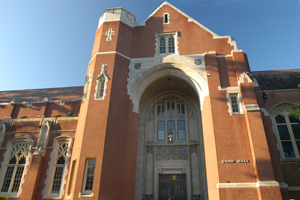Phi Beta Kappa was founded by five students at the College of William and Mary in Williamsburg, Virginia. The first meeting was held in the Apollo Room of the Raleigh Tavern on December 5, 1776. John Heath (right), the first president of Phi Beta Kappa, was determined to develop a student society that would be much more serious minded than its predecessors at the college, one devoted to the pursuit of liberal education and intellectual fellowship. The Greek initials for the society's motto, "Love of learning is the guide of life," form the name Phi Beta Kappa. The first college society to bear a Greek-letter name, ΦBK introduced the essential characteristics of the Greek societies that followed it: an oath of secrecy, a badge, mottoes in Greek and Latin, a code of laws, an elaborate form of initiation, a seal, and a special handshake. The organization was created as a secret society so that its founders would have the freedom to discuss any topic they chose. Freedom of inquiry has been a hallmark of ΦBK ever since. Members greeted each other by drawing the backs of the index and middle fingers of the right hand across the lips from left to right -- affirming that their lips were sealed. They also offered a handshake extending the same two fingers.
The celebrated Phi Beta Kappa key — the prototypical token of membership, now employed by many National Honor Societies founded thereafter. The letters ΦBK are an acronym from the Greek phrase: “Philosophia Biou Kubernetes,” or “Philosophy, the helmsman of life.”The three stars in the upper left corner of the key symbolize Friendship, Morality, and Literature respectively. The pointing hand in the lower right corner represents Aspiration. On the reverse side of the medal, the engraved letters "S P” are acronym for “Societas Philosophize,” or “Society of Philosophy.” This closure would have been the end of ΦBK had the group not earlier agreed to a vision of their only non-Virginian member to establish chapters in New England. Elisha Parmele, a native of Connecticut who had studied at Yale and graduated from Harvard, helped to create chapters at Yale in 1780 and Harvard in 1781, thus ensuring the continuation of the society. In 1831, after anti-Masonic agitation prompted much discussion about the ΦBK oath, Harvard dropped the requirement for secrecy, an action that probably saved the society from further open criticism as well as from rivalry with the social fraternities that made their appearance around that time. Other chapters were added gradually, and the number nationwide stood at 25 in 1883, when the National Council of the United Chapters of Phi Beta Kappa was created. At about the same time, the first women and African-Americans were invited to join ΦBK. The first chapters to induct women were at the University of Vermont, in 1875, and at Connecticut’s Wesleyan University, in 1876. The first African-Americans were elected at Yale, in 1874, and at the University of Vermont, in 1877. Between 1887 and 1917, 64 new chapters were established, and by 1983 another 147 had been chartered. In 1988 the national organization’s name was changed to "The Phi Beta Kappa Society." Today there are 286 chapters at American colleges and universities, and there nearly 50 active alumni associations located in all regions of the country. The first two centuries of ΦBK's existence are described by Richard N. Current in Phi Beta Kappa in American Life: The First Two Hundred Years (Oxford University Press, 1990). |
|||||||



